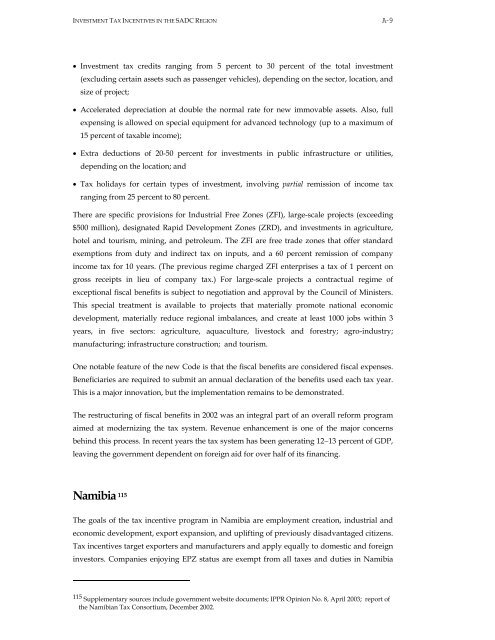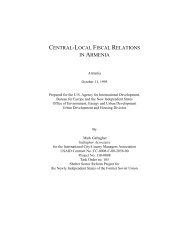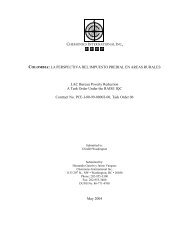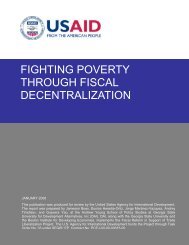Effectiveness and Economic Impact of Tax Incentives in the SADC ...
Effectiveness and Economic Impact of Tax Incentives in the SADC ...
Effectiveness and Economic Impact of Tax Incentives in the SADC ...
You also want an ePaper? Increase the reach of your titles
YUMPU automatically turns print PDFs into web optimized ePapers that Google loves.
INVESTMENT TAX INCENTIVES IN THE <strong>SADC</strong> REGION A-9<br />
•<br />
•<br />
•<br />
•<br />
Investment tax credits rang<strong>in</strong>g from 5 percent to 30 percent <strong>of</strong> <strong>the</strong> total <strong>in</strong>vestment<br />
(exclud<strong>in</strong>g certa<strong>in</strong> assets such as passenger vehicles), depend<strong>in</strong>g on <strong>the</strong> sector, location, <strong>and</strong><br />
size <strong>of</strong> project;<br />
Accelerated depreciation at double <strong>the</strong> normal rate for new immovable assets. Also, full<br />
expens<strong>in</strong>g is allowed on special equipment for advanced technology (up to a maximum <strong>of</strong><br />
15 percent <strong>of</strong> taxable <strong>in</strong>come);<br />
Extra deductions <strong>of</strong> 20-50 percent for <strong>in</strong>vestments <strong>in</strong> public <strong>in</strong>frastructure or utilities,<br />
depend<strong>in</strong>g on <strong>the</strong> location; <strong>and</strong><br />
<strong>Tax</strong> holidays for certa<strong>in</strong> types <strong>of</strong> <strong>in</strong>vestment, <strong>in</strong>volv<strong>in</strong>g partial remission <strong>of</strong> <strong>in</strong>come tax<br />
rang<strong>in</strong>g from 25 percent to 80 percent.<br />
There are specific provisions for Industrial Free Zones (ZFI), large-scale projects (exceed<strong>in</strong>g<br />
$500 million), designated Rapid Development Zones (ZRD), <strong>and</strong> <strong>in</strong>vestments <strong>in</strong> agriculture,<br />
hotel <strong>and</strong> tourism, m<strong>in</strong><strong>in</strong>g, <strong>and</strong> petroleum. The ZFI are free trade zones that <strong>of</strong>fer st<strong>and</strong>ard<br />
exemptions from duty <strong>and</strong> <strong>in</strong>direct tax on <strong>in</strong>puts, <strong>and</strong> a 60 percent remission <strong>of</strong> company<br />
<strong>in</strong>come tax for 10 years. (The previous regime charged ZFI enterprises a tax <strong>of</strong> 1 percent on<br />
gross receipts <strong>in</strong> lieu <strong>of</strong> company tax.) For large-scale projects a contractual regime <strong>of</strong><br />
exceptional fiscal benefits is subject to negotiation <strong>and</strong> approval by <strong>the</strong> Council <strong>of</strong> M<strong>in</strong>isters.<br />
This special treatment is available to projects that materially promote national economic<br />
development, materially reduce regional imbalances, <strong>and</strong> create at least 1000 jobs with<strong>in</strong> 3<br />
years, <strong>in</strong> five sectors: agriculture, aquaculture, livestock <strong>and</strong> forestry; agro-<strong>in</strong>dustry;<br />
manufactur<strong>in</strong>g; <strong>in</strong>frastructure construction; <strong>and</strong> tourism.<br />
One notable feature <strong>of</strong> <strong>the</strong> new Code is that <strong>the</strong> fiscal benefits are considered fiscal expenses.<br />
Beneficiaries are required to submit an annual declaration <strong>of</strong> <strong>the</strong> benefits used each tax year.<br />
This is a major <strong>in</strong>novation, but <strong>the</strong> implementation rema<strong>in</strong>s to be demonstrated.<br />
The restructur<strong>in</strong>g <strong>of</strong> fiscal benefits <strong>in</strong> 2002 was an <strong>in</strong>tegral part <strong>of</strong> an overall reform program<br />
aimed at moderniz<strong>in</strong>g <strong>the</strong> tax system. Revenue enhancement is one <strong>of</strong> <strong>the</strong> major concerns<br />
beh<strong>in</strong>d this process. In recent years <strong>the</strong> tax system has been generat<strong>in</strong>g 12−13 percent <strong>of</strong> GDP,<br />
leav<strong>in</strong>g <strong>the</strong> government dependent on foreign aid for over half <strong>of</strong> its f<strong>in</strong>anc<strong>in</strong>g.<br />
Namibia 115<br />
The goals <strong>of</strong> <strong>the</strong> tax <strong>in</strong>centive program <strong>in</strong> Namibia are employment creation, <strong>in</strong>dustrial <strong>and</strong><br />
economic development, export expansion, <strong>and</strong> uplift<strong>in</strong>g <strong>of</strong> previously disadvantaged citizens.<br />
<strong>Tax</strong> <strong>in</strong>centives target exporters <strong>and</strong> manufacturers <strong>and</strong> apply equally to domestic <strong>and</strong> foreign<br />
<strong>in</strong>vestors. Companies enjoy<strong>in</strong>g EPZ status are exempt from all taxes <strong>and</strong> duties <strong>in</strong> Namibia<br />
115 Supplementary sources <strong>in</strong>clude government website documents; IPPR Op<strong>in</strong>ion No. 8, April 2003; report <strong>of</strong><br />
<strong>the</strong> Namibian <strong>Tax</strong> Consortium, December 2002.











